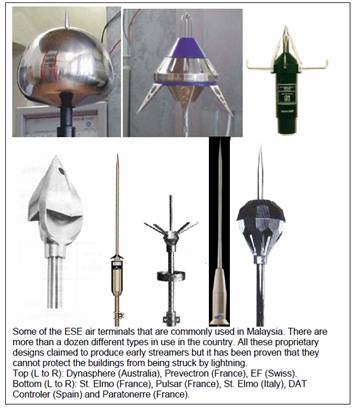Conventional and Un-conventional Lightning Air Terminals: An Overview

Like many electrical products in the market, a Lightning Protection System (LPS) is required to comply with the technical standards set by the IEC or by the respective national standards body (e.g. SIRIM). When such a system complies with the recommendations set in the standard, it is known as a standard LPS. The sale and use of the LPS is legal since it complies with national and/or international standards and has been scientifically proven to provide safety to users.
A paper was written by Hartono and Robiah which reviews the development of the current un-conventional lightning protection air terminals (ATs) and their evaluation based on theory, laboratory and field studies.
The paper reports that un-conventional ATs have been around since the invention of the lightning rod by Benjamin Franklin in the 18th century. However they had never been proven theoretically and practically by their proponents. The current un-conventional ATs, such as the lightning eliminators, the radioactive lightning rods and the early streamer devices, were introduced since the 1970s and they too had never been proven. Although they do not comply with the then and existing lightning protection standards, they were used on many projects in Malaysia and around the world.
This paper describes the principles behind the different methods of lightning protection, and explores the consequences of using non-standard LPS. The paper also discusses the standards proposed for un-conventional ATs over the last decade, and takes a look at the developments in Malaysia in terms of standards implementation and LPS studies conducted by a local university.
Read the entire paper: Conventional and Un-conventional Lightning Air Terminals: An Overview
(Note: the article is 39 pages, 1.88 MG, and may take a few minutes to download, depending on your internet speed).
Hartono Zainal Abidin, BSc (Elect), MIEEE
Robiah Ibrahim, BSc (Elect), MIEEE
FORUM ON LIGHTNING PROTECTION
Hilton Petaling Jaya, 8th January 2004